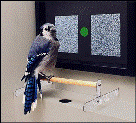Center for Avian Cognition

Avian Cognition Papers
Document Type
Article
Date of this Version
1999
Citation
Published in Animal Behaviour 1999, 58, 477–488.
Abstract
Clark’s nutcrackers, Nucifraga columbiana, store thousands of pine seeds during the autumn and retrieve them throughout the winter. It has been shown that these birds are able to use visual cues to relocate hidden food in the laboratory. In this set of experiments, we trained three groups of Clark’s nutcrackers to find a hidden food goal that was placed in the same spatial location relative to the testing room. During training, the location of two local cues in relation to the goal differed between the three groups. Group 1 learned the task with the cues closest to the goal, group 2 with the cues further from the goal, and group 3 with the cues furthest from the goal. To test whether the proximity of these two local cues to the goal affected how spatial information was used, we manipulated local and global information in a series of experiments. Results indicated that local cues were more important sources of spatial information for group 1, whereas global cues seemed to be used more by birds in groups 2 and 3. These findings suggest that the proximity of visual cues lead to overshadowing of other sources of spatial information surrounding the goal.
Included in
Animal Studies Commons, Behavior and Ethology Commons, Cognition and Perception Commons, Forest Sciences Commons, Ornithology Commons, Other Psychology Commons


Comments
©1999 The Association for the Study of Animal Behaviour. Used by Permission.